June 16, 2023- A Rare Reptile Find
Since we started the Reptile Monitoring Community Science program in 2018 we have had a few species at the top of our ‘must find’ list. Some of these include Spotted and Wood Turtles, Eastern foxsnake, Eastern Hog-nosed Snake, and Massasauga Rattlesnake. These are difficult to find Species at risk that can potentially be found in our region, but knowledge of their presence can help us better manage land to help them thrive. We have scoured suitable habitat for these species over the years in the hope that we will find what we are looking for. During a recent site orientation with Paul Robinson, a new community science volunteer with us this year, Toby came across one of these rare reptiles.
In this case, Paul and Toby stumbled across a juvenile Massasauga, the first to be documented during a Couchiching reptile monitoring visit. As with most snake observations this one was found by chance, through scanning a wetland for turtles when Toby and Paul heard a rustling and faint buzzing. When Toby looked down there was a small (~30-40 cm) Massasauga glaring up and rattling its little rattle! After a quick step back, Toby and Paul were able to get some ID photos and then enjoy being in the presence of such a remarkable species for a few moments before moving on and let it get back to its Massy life.

This species of snake is unique in Ontario as it is our only pit viper, and therefore our only venomous snake. It also has some other unique features such as the rattle, a triangular head, heat sensing pits along its jaw and vertical pupils, which make it stand out from all other snakes you may find here.
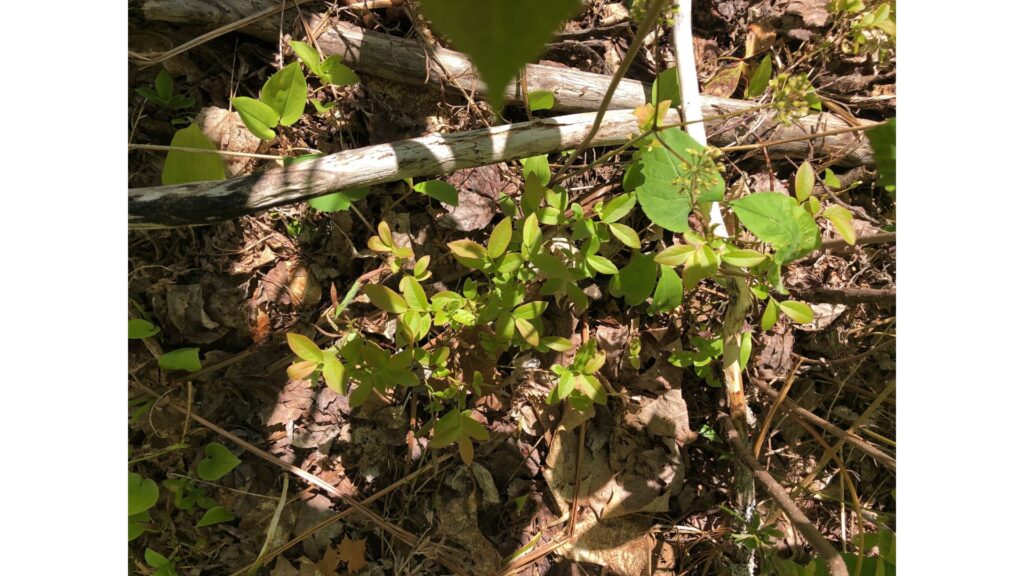
Being prepared and alert in Massasauga territory will make it safer for you and the snakes. To start, make sure you wear close-toed shoes, loose fitting pants, and have your dog leashed when hiking. If you do have the good luck to find one of these fascinating snakes, please make sure to give them the space they need, then take the time to enjoy being in the presence of a rare and unique inhabitant of the region. You can learn more about how to keep yourself, your pets, and the snakes safe by checking out their profile with here and here.
For more on Massasauga Rattlesnakes, visit Ontario Nature: Massasauga Rattlesnake | Reptiles & Amphibians in Ontario | Ontario Nature
June 3, 2023- Carden Bird Blitz!

New and seasoned volunteers met at the Carden Alvar at sunrise for the annual Carden Bird Blitz. Six teams of birders visited 31 stations in total, performing a 5-minute bird count at each and keeping track of birds seen and heard between point count locations. This is one of the longest running grassland bird studies in Ontario and helps us protect the diversity of birds living on the Alvar, including Species at Risk.
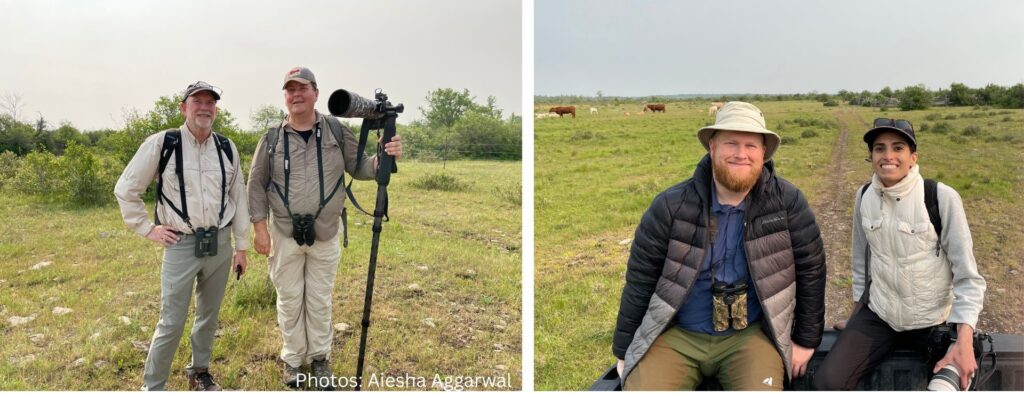
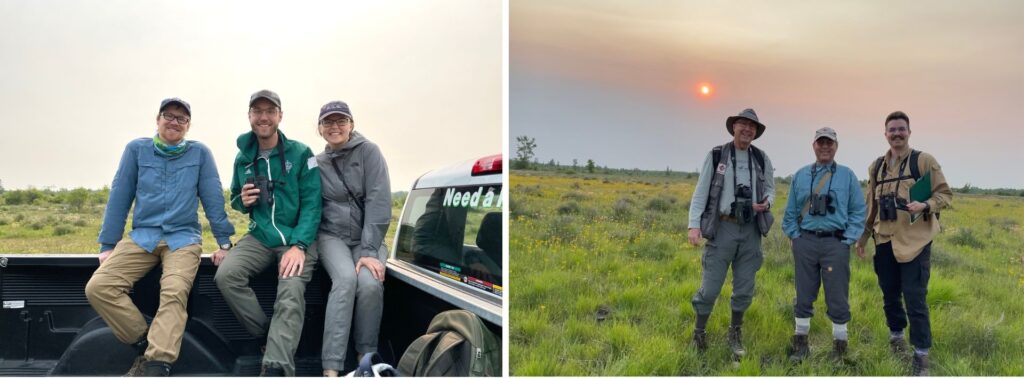
The teams encountered a variety of grassland birds from Eastern meadowlarks to Wilson’s snipe and grasshopper sparrows. Some special sightings included an upland sandpiper, golden-winged and blue-winged warblers, and nesting Loggerhead shrike!
Thank you to all volunteer birders and our ambassadors, Ann and Neil, during another successful Carden Bird Blitz! And, a special thanks to Canadian Tire and Panacea for supporting this event!
June 2, 2023- Exploring Couchiching Properties & Community Science Project
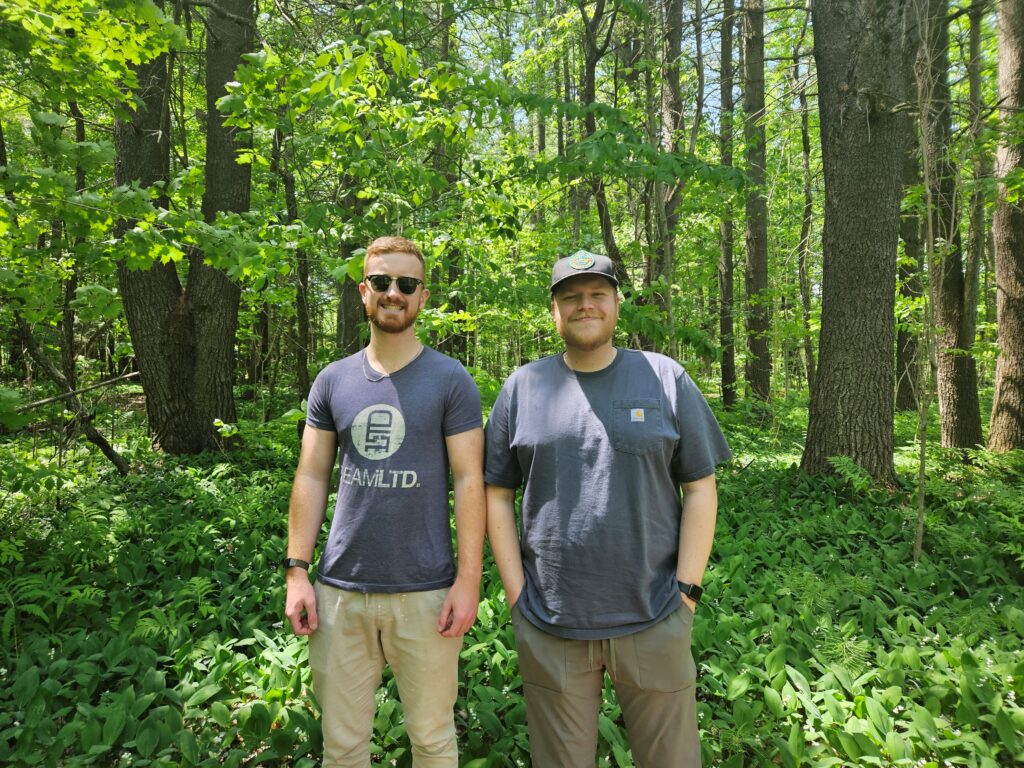
Meet Carsten and Quin! They’re working with us this year as part of the Canada Summer Jobs Initiative to gain experience in the conservation work. If you’re a volunteer with us and haven’t met them yet, you’re likely to run into them at our office or a Nature Reserve this summer. So far they’ve helped us prepare for community science programs and trainings, organize and track data, and take care of some land steward tasks out on properties.
Carsten and Quin are getting familiar with Couchiching properties. They’ve had some chances to explore our beautiful natural areas and participate in community science training.
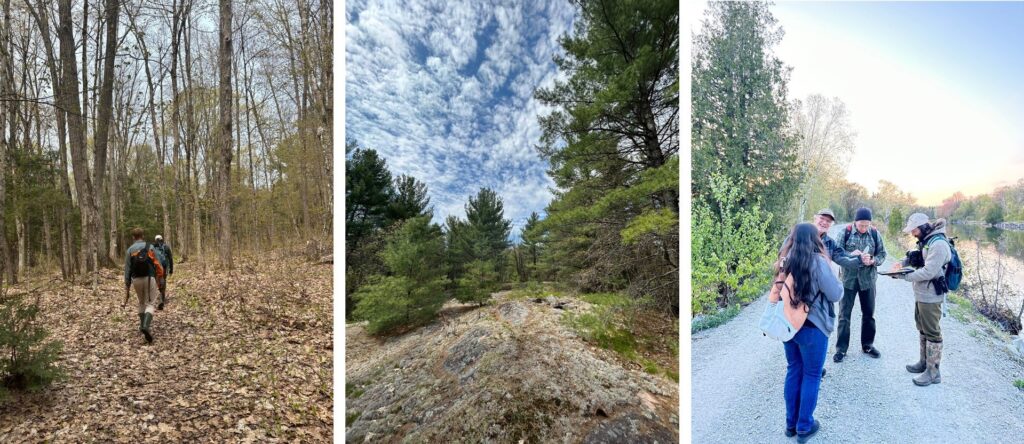
Right: Toby, Stewart, Bryan, and Megan accompanied Carsten & Quin for Bat Monitoring Training at T.C. Agnew.
To learn more about our summer staff, read their bios here.
May 12, 2023- Snake Monitoring at the Frantzke Williamson Conservation Easement
Summer Staff Carsten and Quinlan, Field Biologist Toby, and volunteers Courtney and Stella (9yo) visited the Frantzke Williamson conservation easement for some Friday night snake monitoring.
They were rewarded with three beautiful juvenile snakes!
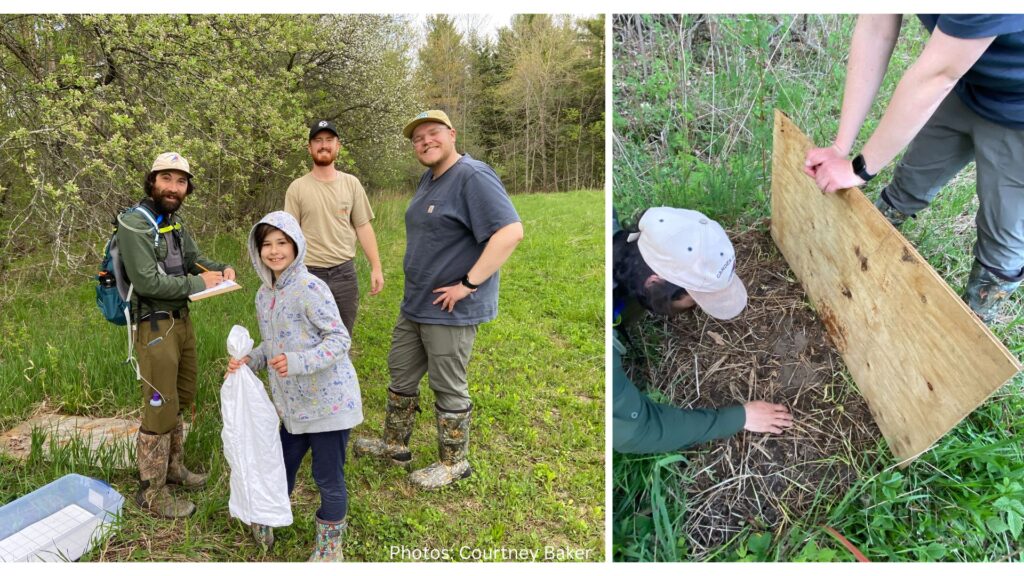
The group lifted plywood snake boards to inspect the ground beneath for these stealthy characters. When snakes were present, they were gently lifted into a pillowcase while the team searched for more individuals. Once staff/volunteers accounted for all individuals, the snakes were measured, sexed, and carefully placed back on the ground to slither away under their board.
*Note that many precautions are taken during Couchiching Conservancy Snake monitoring to protect the snakes and staff who are handling. Staff have permits for this activity. We discourage anyone from handling snakes without proper training and permits, both for human safety and safety of the snakes.
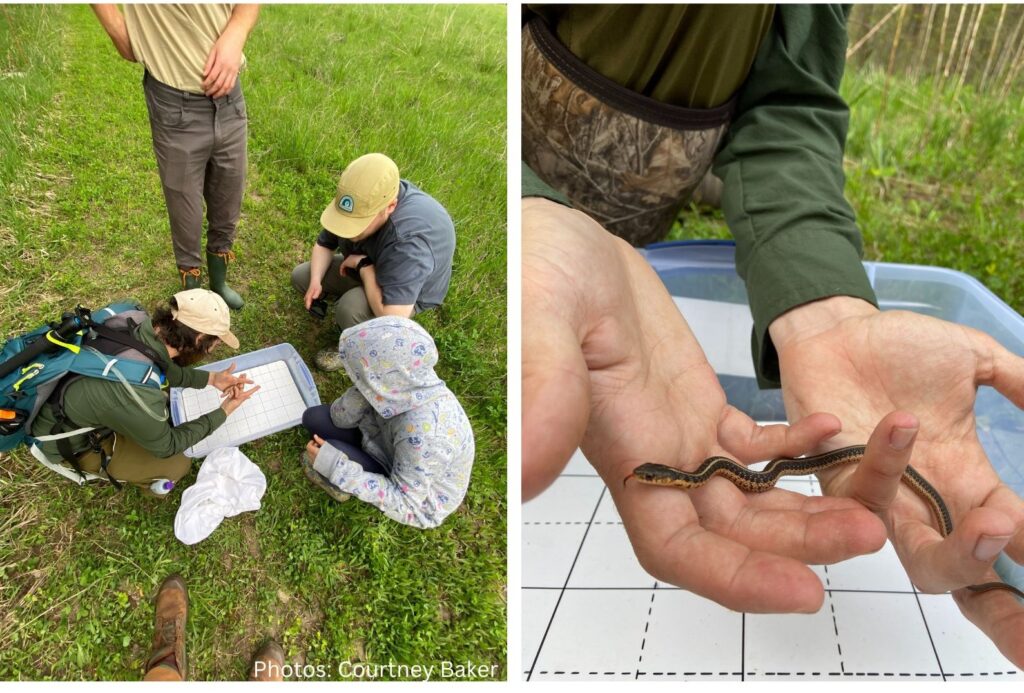
April 21, 2023- Unexpected Wildlife Encounters
Our community science volunteers follow monitoring protocols to search for specific species. Often, while doing their monitoring, volunteers come across wildlife that they weren’t searching for. These incidental observations are valuable and help us learn more about the species present at Nature Reserves in the region.
During their April 11 daytime Frog Monitoring visit, Morris and John came across a moose, a fisher, and Eastern bluebird at Bluebird Ranch.

Right: A moose posing for the camera. Photo credit John F. Wright.
On April 21, Sam and Aiesha were monitoring for frogs at a forest vernal pool. When they looked into the pool, they observed spotted salamanders swimming! Be on the lookout for surprise species observations on your next trip out to a Couchiching Conservancy Nature Reserve!
April 2, 2023 – A strong start to amphibian monitoring
Amphibian monitoring is an important part of our data collection at The Couchiching Conservancy. Many frogs, toads, and salamanders are in decline. Consistent observation helps us understand which areas are valuable high quality amphibian habitat, and which areas could benefit from habitat improvements.
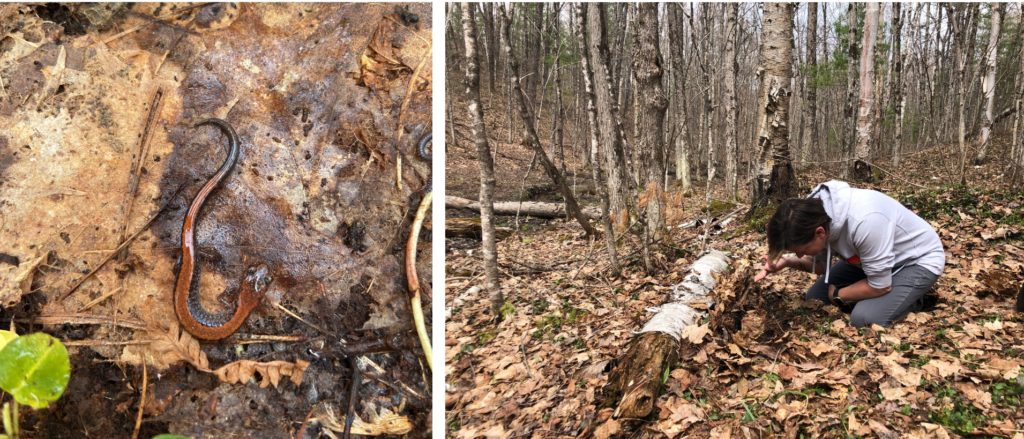
On April 2, Erin Wall, a new Salamander Monitor, was oriented to her monitoring site by Toby Rowland on a nice warm sunny day with no bugs (always appreciated). They found six Eastern red-backed salamanders, two of which were the more unusual leadback phase of the species. The leadback phase can sometimes be confused with the more uncommon blue-spotted Salamander, but can be differentiated by its more slender body. The head is only slightly wider than the body and it has tiny spindly legs that look like they are not quite up to the job of locomotion! The clear and opaque egg masses you can see in the photo are both from spotted salamanders, it is not clear why these differences occur, but each individual female will lay the same colour egg masses throughout her life.
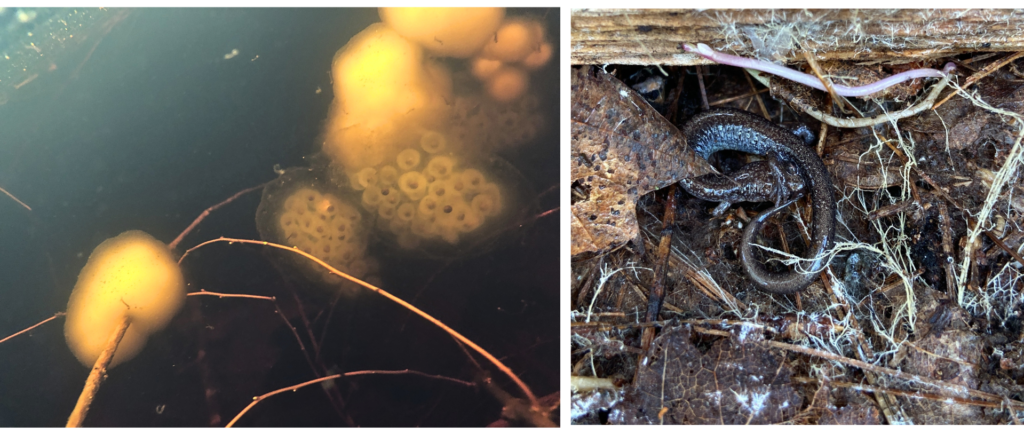
Photo credit: Toby Rowland and Erin Wall.
Erin and Toby also found three different species of turtle, a porcupine, and a variety of birds including the melodic hermit thrush. The turtles were quite exciting with three Midland painted Turtles, two snapping turtles, and ten Blanding’s turtles. This is a record for most Blanding’s Turtles seen on a Couchiching Nature Reserve during a single monitoring visit!
April 11, 2023 – How should a beaver cross the road?
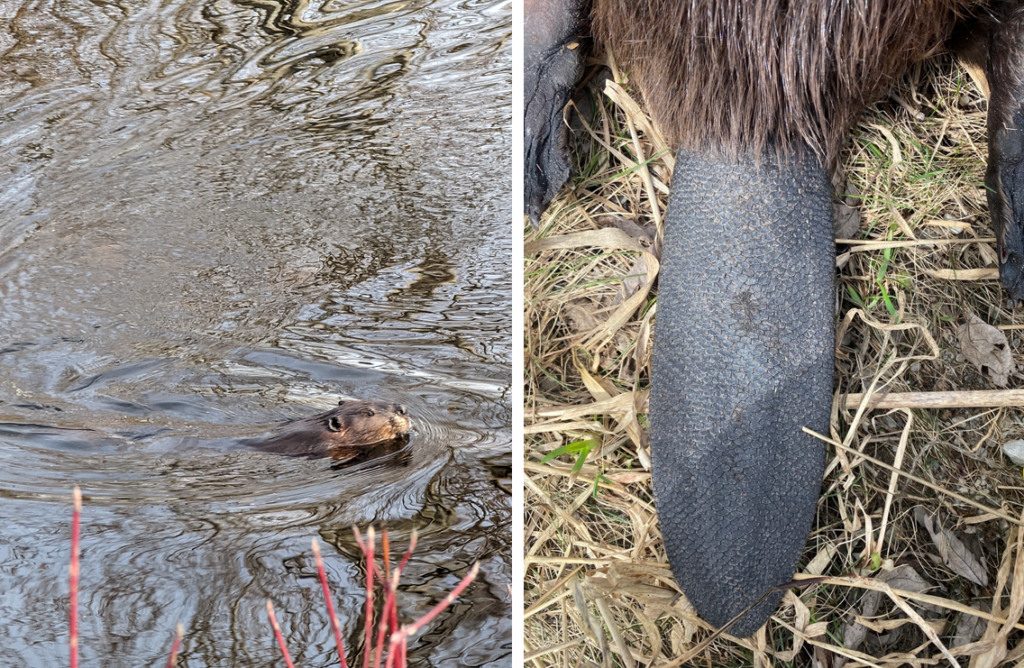
Alysha went out to the Whitney & McIsaac Wetlands to install driveway markers, and to determine if chorus frogs were out calling. She was welcomed by the trill of chorus frogs coming from some flooded brush. Alysha also runs the Wildlife on Roads monitoring program, and routinely monitors for roadkill near Couchiching Conservancy properties, including on Whitney & McIsaac Wetlands. While she was there, she decided to complete a Wildlife on Roads monitoring visit.
Sadly, she found Monck Road’s most recent traffic victim, a beaver, about 25 feet from the asphalt on the North side of the road. It chose to brave the road instead of using a culvert installed in 2021 for habitat connectivity on either side of the road.
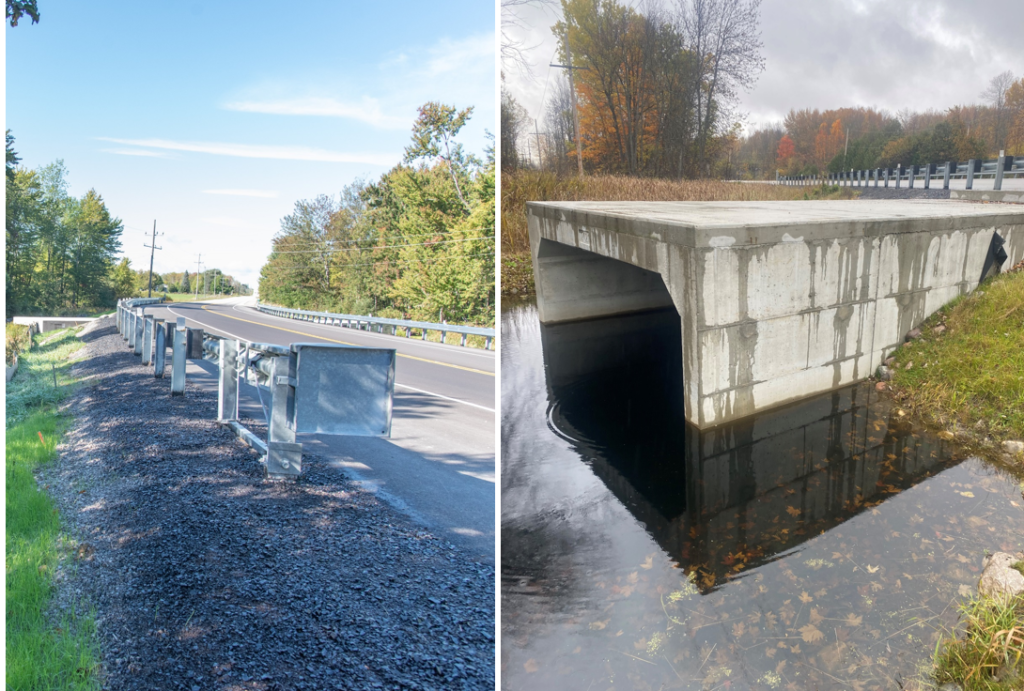
Right: Monk Road culvert dividing the wetlands on the North & South sides of the road.
As the weather warms, this beaver will not be the last road fatality on Monck Road. We hope to gain a better understanding of wildlife-road interactions through the hard work of our volunteers in the Wildlife on Roads monitoring program. Soon, we also aim to build fencing along the road in this location to protect wildlife by encouraging them to use the culvert instead of the road.
The Wildlife on Roads monitoring program is funded by the Angela Rehhorn Community Science Fund, Transport Canada, and our generous donors.

